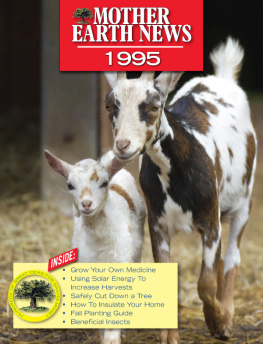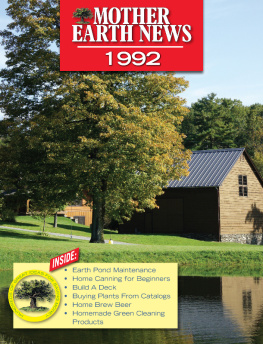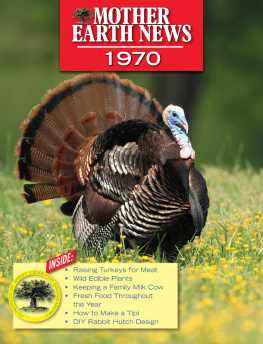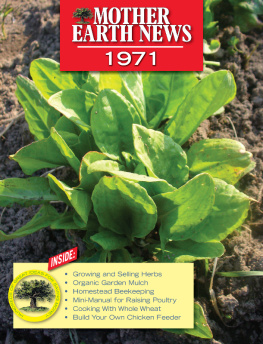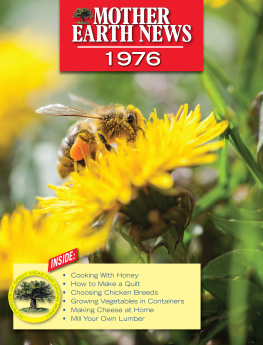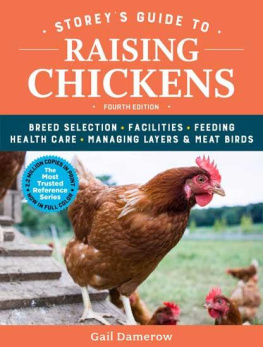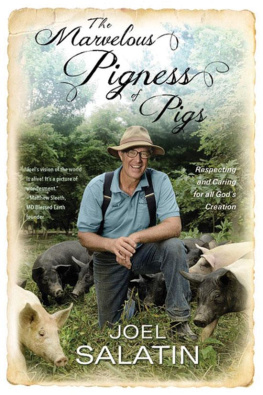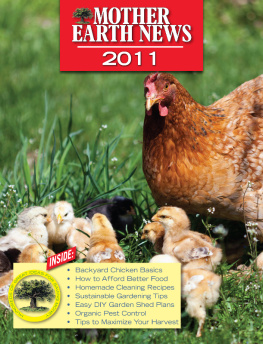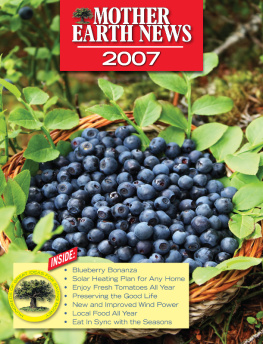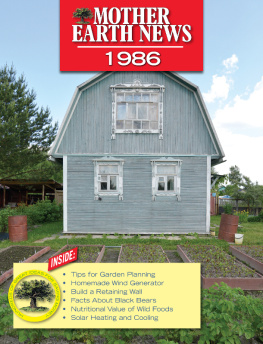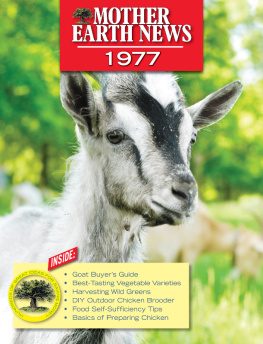Mother Earth News - Mother Earth News 1995
Here you can read online Mother Earth News - Mother Earth News 1995 full text of the book (entire story) in english for free. Download pdf and epub, get meaning, cover and reviews about this ebook. year: 1995, publisher: Mother Earth News, genre: Science / Home and family. Description of the work, (preface) as well as reviews are available. Best literature library LitArk.com created for fans of good reading and offers a wide selection of genres:
Romance novel
Science fiction
Adventure
Detective
Science
History
Home and family
Prose
Art
Politics
Computer
Non-fiction
Religion
Business
Children
Humor
Choose a favorite category and find really read worthwhile books. Enjoy immersion in the world of imagination, feel the emotions of the characters or learn something new for yourself, make an fascinating discovery.
- Book:Mother Earth News 1995
- Author:
- Publisher:Mother Earth News
- Genre:
- Year:1995
- Rating:3 / 5
- Favourites:Add to favourites
- Your mark:
- 60
- 1
- 2
- 3
- 4
- 5
Mother Earth News 1995: summary, description and annotation
We offer to read an annotation, description, summary or preface (depends on what the author of the book "Mother Earth News 1995" wrote himself). If you haven't found the necessary information about the book — write in the comments, we will try to find it.
Mother Earth News 1995 — read online for free the complete book (whole text) full work
Below is the text of the book, divided by pages. System saving the place of the last page read, allows you to conveniently read the book "Mother Earth News 1995" online for free, without having to search again every time where you left off. Put a bookmark, and you can go to the page where you finished reading at any time.
Font size:
Interval:
Bookmark:

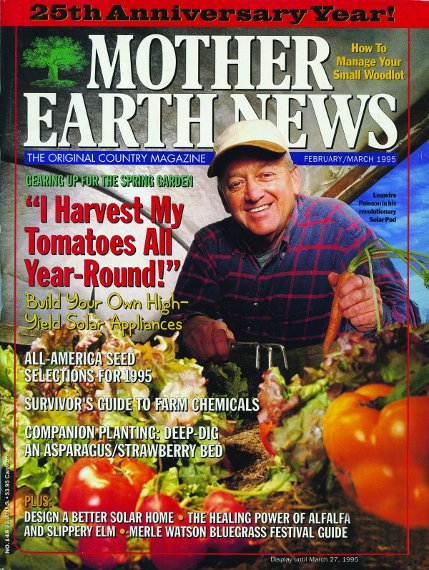
Gophers: After watching both young and mature plants disappear overnight from my vegetable garden, gobbled from the bottom up by gophers, the following year I decided to foil those critters by planting in raised beds out of their reach. Since I didnt have the ability or funds to build those beds, I used tires instead, stacked two high. I learned that you have to pack them clear to the rims inside with soil to keep other critters out, like wasps. I also found that the heat provided by the tires boosted my warm weather crops here in the mountains where the summers can be cool and short. To be on the safe side, I inserted a tall garden pot in one of the tires to provide additional protection for the parsley with its long, tempting taproot. Voila! No more plants lost to gophers.
Compost: Burying my kitchen garbage in the compost had two disadvantages: 1) the wild animals dug it up and ate it, and 2) in the winter, the heap was frozen and I couldnt bury the garbage. Now I use a two-bin system, which is simply two stacks of tires, three tires each.
The garbage is dumped into one stack and I cover it with a shovelful or two of dirt (mixed with sand and ashes in the winter). I chop the garbage and dirt with the end of the shovel. When one stack is full, I start on the other one. By the time that one is full, the other is composted. If you have more garbage than I do, then youll need more stacks. They work perfectly. The heat provided by the black rubber speeds up the composting process, and they are easily disassembled when its time to empty them.
Deep Planting on Poor Ground: In some places where I wanted to plant shrubs, the ground was like concrete with practically no topsoil. I used both car and truck tires to provide raised beds for them. These contained beds also made it easier to keep the shrubs watered. In time the water and nutrients worked on the soil beneath the ground level so that the roots could expand. Well okay, despite their advantages, tires are not attractive, so I surrounded them with stones, piling them up until they covered all the rubber. The shrubs are happy and so am I.
-Joanna James
Mosier, Oregon
Hard water and soap stains on plastic or fiberglass tub surrounds can be avoided by applying boat wax to the surface when it is new. Car wax will also do the job, but I think fiberglass wax is better.
-Carl Bettrens
Lawrence, KS
No one is a stranger to the burning, teary-eyed perils of working with hot peppers, but heres a first line of defense for your hands. Before cutting into the peppers, wash your hands, dry thoroughly, and pour a small amount of apple cider vinegar into them. Rub hands together until they are wet and then let them air dry. Peppers will be powerless to burn your hands after that. But you still have to keep them away from your eyes!
-Betty Redden
Taylors, SC
My garden is an eight-by-four oval space. I have set out four early-girl tomato plants and four super-fantastic tomato plants and three cucumber plants. It has always been my goal to have tomatoes by the fourth of July and this year was no exception. Maturity of early-girls is 52-54 days; super-fantastic, 70 days. When I cleaned the garden out last year, I added calcium. It is very important that the tomatoes have sufficient calcium: without it, they will develop blossom end rot. To plant tomatoes, dig a hole approximately 10 to 12 inches deep and wrap the roots of the plants in brown paper (from paper bags). Then put some nitrogen-rich fertilizer in the hole before you insert the plant. I group my tomatoes together, so they can pollinate each other, and use a common lattice inserted in the ground to keep the tomatoes up. Also, plant marigolds around the perimeter-this will discourage pests that would like to eat your plants. When the tomatoes start to set, spray them with a liquid fertilizer. If it doesnt rain, water them every two or three days to at least one inch deep. Spray the liquid fertilizer at least two or three times. I have several pieces of chickenwire that I move around to keep the birds from eating the tomatoes-the cucumbers will take care of themselves.
P.S. I have given away tomatoes, made tomato juice, and I am going to sun-dry some and still there are tomatoes EVERYWHERE.
-Chloe Chitwood
Knoxville, TN
During the winter and early spring, as I plan my garden and other projects for the upcoming summer, I also draw up a list of the tools and materials I will need. When I happen across a missing or broken item (an invariable occurrence all winter long), I jot it down. When warm weather arrives, my garage sale shopping list is ready. Last year I found almost everything on the list, including a crowbar and pitchfork, and never once was caught in the middle of the garden without that crucial tool.
After groping in the dark for matches during a recent electrical outage, I was determined never to be caught in that predicament again. Now, I tape a book of matches under the hollow base of every kerosene lamp in the house.
-Ruth F. Jacobs
Gallipolis, OH
PHOTO: JERRY HOWARD/POSITIVE IMAGES
250,000,000 used tires are added to disposal sites like this one each year.
The recent cutbacks in the fish trade have left many hard-working people without jobs. The government has enforced some drastic regulations on those in the fish business including limiting the grounds that can be fished, the days each boat can fish, and the size of catches that are permitted. Although the governments intention is to try to preserve existing fish stocks, their regulations have induced a 50% job loss among fish workers.
Neptune Harvest, a division of Ocean Crest Seafoods, Inc., of Gloucester, Massachusetts, has come up with a way of putting people back to work and something back in the environment-recycled fish.
Pondering the waste of fish parts that are left when the fillet (or the parts you and I eat) is cut from the fish gave the folks at Ocean Crest Seafoods, Inc., an idea. They decided to turn the leftover fish parts into healthy fertilizer.
While using fish parts is not an entirely new idea, they use a special cold process in turning the fish into the fertilizer that is particularly good for your garden. They take fresh fish and grind it, breaking down peptide bonds to the smallest element so the fish becomes liquefied. Salvatore Parco, vice president of Neptune Harvest, insists on using only fresh fish. If youre going to start off with something that smells stinky, youre just not going to get good results, he says.
The fish is not cooked and heat is never used, so valuable vitamins, nutrients, and amino acids remain intact. Many fish fertilizers are solubles that come as a byproduct when cooking the fish. Often processing plants cook at temperatures ranging from 300 to 500F and many heat-and light-sensitive nutrients are lost as a result. The people at Neptune Harvest like to think of their process as the difference between eating a cooked vegetable and a raw vegetable. Sure, a cooked vegetable can be good for you, but a raw vegetable is better. Another perk to the cold process is that it is less malodorous, making it a little easier on the sensitive noses of the fish workers.
Font size:
Interval:
Bookmark:
Similar books «Mother Earth News 1995»
Look at similar books to Mother Earth News 1995. We have selected literature similar in name and meaning in the hope of providing readers with more options to find new, interesting, not yet read works.
Discussion, reviews of the book Mother Earth News 1995 and just readers' own opinions. Leave your comments, write what you think about the work, its meaning or the main characters. Specify what exactly you liked and what you didn't like, and why you think so.

